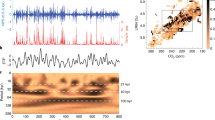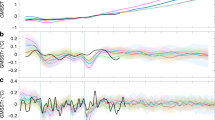Abstract
THERE is now ample instrumental, historical and proxy evidence for palaeoclimatic variability over time scales ranging from 10 to 109 yr (ref 1). Although a great deal of research is still needed to establish more precisely the nature and finer spatial and temporal resolution of these changes, the main theoretical problem is to understand the mechanisms responsible for this variability over such a wide range of time scales. We suggest here that if the Sun were almost-intransitive, it could explain some of this climatic variability. Many hypotheses have been advanced by researchers in various disciplines based on physical processes, both terrestrial and extra-terrestrial1–8 and although there is no general consensus as to the causes of variability over various time scales, the common view among climatologists is that the very long time-scale fluctuations with periods of ∼108 yr can be explained by causes of terrestrial origin, such as the changes in oceanic and continental geometries3,10. The intermediate time-scale fluctuations with periods of ∼104–105 yr are thought to have been caused by variations in Earth's orbital elements9. The relatively short time-scale fluctuations with periods of ∼102–104 yr are, on the other hand, hard to explain, because of the clear lack of a physical process with the appropriate time scale. Solar variability is, however, accepted as a serious contender3,10. All these hypotheses, whether terrestrial or extra-terrestrial, have in common the assumption that the changes in climate are deterministic, that is, they are a causal response of the climatic system to a change in some environmental (internal or external) parameter, even though the actual mechanism of change is not usually understood.
This is a preview of subscription content, access via your institution
Access options
Subscribe to this journal
Receive 51 print issues and online access
$199.00 per year
only $3.90 per issue
Buy this article
- Purchase on Springer Link
- Instant access to full article PDF
Prices may be subject to local taxes which are calculated during checkout
Similar content being viewed by others
References
Understanding climatic change: a program for action, Report of GARP Panel on climatic variations (US National Academy of Sciences, Washington, D. C. 1975).
Mitchell, J. M., Jr Meteor. Monogr. 8, 155 (1968).
Mitchell, J. M., Jr, Quat. Res. 6, 481 (1976).
Kutzbach, J. E. Quat. Res. 6, 471 (1976).
McCrea, W. H. Nature 255, 607 (1975).
Clark, D. H., McCrea, W. H. & Stephenson, F. R. Nature 265, 318 (1977).
Wdowczyk, J. & Wolfendale, A. W. Nature 268, 510 (1977).
Begleman, M. C. & Rees, M. J. Nature 261, 229 (1976).
Hays, J. D., Imbre, J. & Shackleton, N. J. Science 194, 1121 (1976).
Hays, J. D. in The Solar Variability and its Variations, 73 (ed. White, O. R.) (Colorado Associated Press, Boulder, 1976).
Damon, P. E. in The Solar Variability and its Variations, 429 (ed. White, O. R.) (Colorado Associated Press, Boulder 1976).
Eddy, J. A. in The Solar Variability and its Variations, 51 (ed. White, O. R.) (Colorado Associated Press, Boulder, 1976).
Gough, D. O. in The Solar Variability and its Variations, 451 (ed. White, O. R.) (Colorado Associated Press, Boulder, 1976).
Lorenz, E. N. Meteor. Monogr. 8, 1 (1968).
Lorenz, E. N. J. appl. Meteor. 9, 325 (1970).
Lorenz, E. N. Quat. Res. 6, 495 (1976).
Hide, R. Phil. Trans. R. Soc. A250, 441 (1958).
Flohn, H. GARP Publications Series, No. 16 (WMO-ICSU, Geneva, 1975).
Suess, H. Meteor. Monogr. 8, 146 (1968).
Damon, P. E. Meteor. Monogr. 8, 151 (1968).
Roxburgh, I. W. Proc. 2nd European Conf. on Solar Physics (ed. Rosch, E. in the press).
Author information
Authors and Affiliations
Rights and permissions
About this article
Cite this article
TAVAKOL, R. Is the Sun almost-intransitive?. Nature 276, 802–803 (1978). https://doi.org/10.1038/276802a0
Received:
Accepted:
Published:
Issue Date:
DOI: https://doi.org/10.1038/276802a0
This article is cited by
-
Models for the long-term variations of solar activity
Living Reviews in Solar Physics (2023)
-
“TOY” Dynamo to Describe the Long-Term Solar Activity Cycles
Solar Physics (2006)
-
The Maunder Minimum and the Solar Dynamo
Solar Physics (2004)
-
El Niño: Evidence for climatic nondeterminism?
Archives for Meteorology, Geophysics, and Bioclimatology Series B (1984)
-
Environmental fluctuation effects on the global energy balance
Nature (1979)
Comments
By submitting a comment you agree to abide by our Terms and Community Guidelines. If you find something abusive or that does not comply with our terms or guidelines please flag it as inappropriate.



